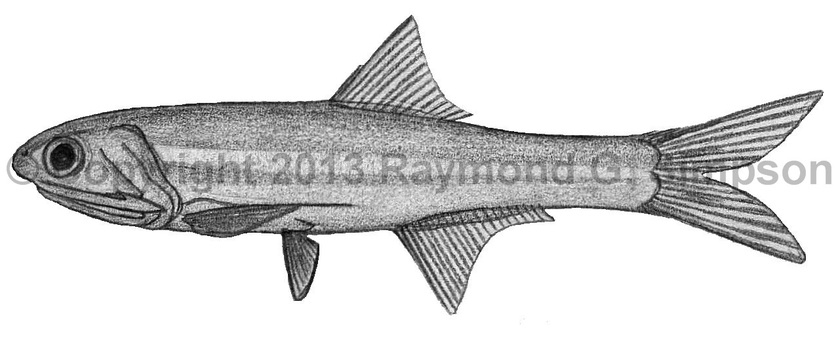
Common Name
Longfinger Anchovy
Year Described
Fowler, 1915
Identification
Dorsal Fin: 13-15
Anal Fin: 19-23
Pectoral Fin: 13-14
Gill Rakers: 17-19 upper, 20-23 lower
Vertebrae: 39-40
Lateral Line Scales:
Body elongate and laterally compressed. Snout conical and about equal to eye diameter. Mouth very large and inferior. Maxilla tip extends over preoperculum to nearly opercular edge. Teeth small. Suborbital bone much larger than eye diameter. Pseudobranch longer than eye diameter and extends onto operculum. Dorsal fin origin a little past midpoint of body with a concave rear margin. Pectoral fin long and has a filamentous tip reaching well past pelvic fin in larger fish. Pelvic fin equally distant from anal and pectoral fin. Pelvic fin with seven rays. Anal fin origin under last rays of dorsal fin and has a long base. Caudal fin forked. Anus closer to anal fin than pelvic fin base. Scales cycloid and deciduous. Lateral line absent.
Color
Body translucent with a wide (about eye diameter) silvery stripe that does not narrow significantly. Fins clear.
Size
Maximum size to 120mm TL.
Habitat
An inshore species found in clear marine waters but not in low salinities. Schooling.
Range
Cuba and the Caribbean islands to Brazil.
References
Hildebrand, S.F. 1964. Engraulidae and Clupeidae (pp. 152-454). In: Fishes of the Western North Atlantic. Mem. Sears Fnd. Mar. Res. 1 (Vol. 3): 1-630.
Other Notes
This and Anchoa lyolepis are the only Caribbean anchovies with a long pseudobranch filament patch extending onto opercular flap. The filamentous pectoral fin ray is unique to this species.